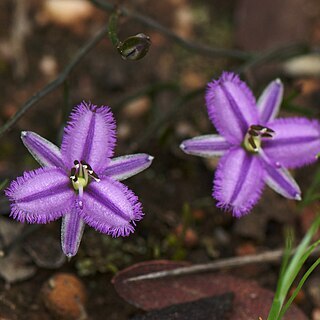Perennial herbs, sometimes rhizomatous; roots fibrous or tuberous. Leaves annual, often withering early, perennial or absent. Flowering stems annual or perennial, scandent in 2 species, often scapose. Flowers bisexual, actinomorphic, pedicellate, single or in c. 2-50-flowered umbels; flowers or umbels single and terminal, in paniculate or cymose inflorescences, or scattered on stem. Perianth segments 6, free, usually pale purple. Sepals linear to lanceolate, membranous-edged. Petals elliptic; margins fringed. Stamens 3 or 6; anthers of 2 whorls equal or unequal in length, dehiscing by terminal pores or by full-length slits, introrse or latrorse. Ovary superior, 3-locular; ovules usually 2 per locule; placentation axile; style straight or curved. Fruit a loculicidal capsule enclosed within persistent perianth. Seeds black, arillate.
Herbs perennial, with a short or elongate rhizome. Leaves basal or nearly so, grasslike, sometimes very narrow, flat or terete. Scape axillary. Inflorescence usually a terminal raceme or panicle, less often an umbel or solitary flower; bracts small. Flowers bisexual; pedicel articulate proximally. Tepals 6, free, persistent; outer ones entire; inner ones usually fimbriate-ciliate at margin. Stamens 6, included, inner ones sometimes reduced; filaments rather short; anthers basifixed, inner ones usually longer. Ovary 3-loculed; ovules 2 per locule. Style filiform; stigma small. Fruit a loculicidal capsule. Seeds few, black.

